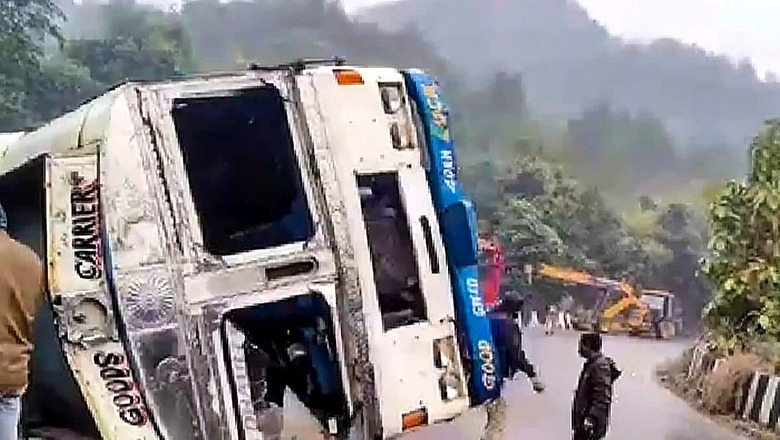
views
I write this op-ed piece from one of the oldest cities of Bharat, Pataliputra (modern-day Patna), the state capital of Bihar. And the immediate trigger of the piece is my dismay at a small news item in the local newspaper: “On August 22, 2024, in various road accidents in nine districts of Bihar at least 17 people lost their lives and nearly two dozen were injured badly.” On their own volition, the state police have identified 17 Bihar districts that have witnessed an alarming rise in road accidents; they have also vowed to identify the “black spots” where maximum accidents happen.
One often reads similar news items from other states too. With the poor record of recording and reporting road accident-related fatalities in various parts of the country, I believe the actual number of deaths and injuries related to road accidents must be much higher than reported.
Also, in this connection, a few questions have always troubled me: How serious is the conundrum of road- and highway-related accidents and fatalities in the country? What actions, if any at the level of central and state governments, have been initiated to improve the situation? And, why doesn’t Bharat doggedly pursue ‘Mission Zero Fatalities’ on its roads and highways?
The Cobweb
As per the latest government data, Bharat has a complex cobweb of 66.71 lakh km of road network, which is the second largest in the world. This includes 1,46,145 km of national highways, 1,79,535 km of state highways, and 63,45,403 km of other roads. A common characteristic of all these roads spread across the length and breadth of the country is that they are probably the most unsafe on the planet. Also, the number of registered vehicles across the country was over 326 million in fiscal year 2020. Vehicle registrations grew at a compound annual growth rate of over nine per cent between fiscal years 2010 and 2020. This cobweb forms the backdrop of increasing road accidents in the country.
The Black Hole
The country lacks credible data regarding the number of people getting killed or injured seriously in fatal road and highway accidents daily. The annually tabulated and published data by the National Crime Records Bureau (NCRB) and Ministry of Road Transport and Highways (MoRTH) are not reliable. There exist serious issues related to both the quality of the source data and the methodology adopted to arrive at the number of accidents and casualties in road accidents. I will discuss the road accident data a bit later. Before that a peep into the global scenario.
The Global Decline
The consensus estimate puts the global deaths in road crashes around the world between 1.20 million and 1.35 million. A key characteristic of these road fatalities is that more than 90 per cent of them are concentrated in low- and middle-income countries like Bharat while the contribution of road accident deaths in developed countries is minuscule.
Instructively, as per the data emanating from the “WHO’s Global Status Report on Road Safety 2023” between 2010 and 2021, road accident deaths fell by 5 per cent to 1.19 million fatalities annually worldwide with 108 UN member nations reporting a drop. This is despite the fact that in the intervening period, the global population increased by nearly 14 billion and the global motor vehicle fleet also grew 160 per cent.
This leads me to the question: What is the Bharat story?
Numbers Do Not Match
I humbly posit that despite NCRB and MoRTH collecting and reporting annual road accident statistics, there is no reliable data on road- and highway-related accidents and consequent fatality data in the country.
As per the Ministry of Road Transport and Highways, report on “Road Accidents in India-2022”, based on the information received from the state police, in 2022 a total of 461,312 road accidents were reported by States and Union Territories (UTs) resulting in 168,491 deaths and causing injuries to 443,366 persons.
As per NCRB data for the same year, a total of 446,768 road accident cases were reported during 2022 which accounted for 171,100 deaths. Even though the aggregate data of NCRB and MoRTH somewhat tally, the two sets of numbers show substantial variance in spatial distribution, age-wise distribution of deaths and injuries as well regarding numbers of deaths of pedestrians, cyclists, two-wheeler riders along with that of truck-occupant casualties and data of deaths of occupants of cars, jeeps, and other light vehicles.
Though I lack the hard data to prove my statement, given the inability of the state governments to record and report the accident data properly, I suspect that at a minimum, anywhere between 250,000 and 300,000 people are killed in road accidents and close to half a million injured annually, “maimed for life, whether due to serious head injuries or losing their limbs being a matter of detail”.
The Dangerous Pit
I dare say that people in Bharat live along and traverse the most dangerous roads in the world and the actual number of annual casualties in road accidents in the country at best remains a guesswork in the absence of reliable hard data.
Ironically, the situation has become alarming despite very low per capita vehicular penetration in the country. According to a World Bank study, with barely 1 per cent of the world’s vehicles, Bharat accounts for about 6 per cent of global road traffic incidents and almost 10 per cent of all crash-related deaths. With decreasing world road accident casualty and increasing fatalities on Indian roads, the percentage of Indian casualty to global casualty just crossed 15 per cent and is heading fast towards 20 per cent.
Bharat Rising
An analysis of the official numbers (from MoRTH) of road accidents and casualties shows a disturbing trend. Between 2002 and 2010, the number of road accidents in Bharat increased from 407,497 to 499,628 while the number of people killed in those accidents increased from “84,674 to 134,513”, an increase of 59 per cent.
In recent years, the best performance of the country was in 2020, with 131,714 fatalities in road accidents, a 12.84 per cent decrease from 2019. The total number of accidents also decreased by 18.46 per cent to 366,138, and the number of injuries decreased by 22.84 per cent to 348,279.
But the above decrease was largely owing to the two lockdowns due to the Covid-19 pandemic that kept vehicles off the road. In 2021, fatalities increased to 155,600 from 131,714, with 371,884 injured; and in 2022, fatalities rose to 168,491 deaths and injuries to 443,366 people.
The Curse
The casualty from road accidents in the country is a curse beyond comprehension. In terms of sheer numbers, it is many times more than the combined fatality from natural disasters (8,000 deaths in 2023), terrorism (148 deaths in 2023, and 506 deaths in 2022) and internal disturbance like Naxalism (less than 1,000 people, security forces and Naxalites taken together).
Also, in its impact, it is more serious. Most Indians who perish in road accidents are pedestrians, cyclists and those riding two-wheelers. Worse, many of them are from the age group 14-29, with the working group population being the maximum casualty.
Human Errors
Over half of all road fatalities took place on national and state highways — though they make up less than 5 per cent of Bharat’s total road network. Indubitably, the expansion in the road network along with high permissible speed on improved roads and highways, a surge in motorisation and a fast-rising population in the country contribute towards the increasing numbers of road accidents, as well as related injuries and fatalities. This is aggravated by driver error, including rash driving and non-observance of traffic regulations.
Human errors account for the maximum number of road accidents. A case in point is overspeeding which accounts for more than 70 per cent of Bharat’s total road accidents. Driving on the wrong side was the second highest cause, followed by drunk driving and the use of mobile phones while behind the wheel.
Towards Solution
With a disproportionately high number of road crashes in the country resulting from human errors, it calls for twin actions: First, stricter laws; and second, strict enforcement by the enforcement system.
Additionally, there is an urgency to adopt a comprehensive approach to address the contributing factors leading to road accidents, including speeding, reckless driving, drunken driving, and non-compliance with traffic regulations. There is also a critical need to enhance driver education and training programmes and invest in improving the condition of roads and vehicles.
Make no mistake, it is possible to prevent as well as substantially reduce road accidents because only three variables are to be controlled that are common to every accident — a driver, a vehicle, and the road infrastructure. With causes known, the solution need not be far away
The Imperative
On road accidents, it is a wake-up moment for us — a time to substantially reduce such accidents, a goal already achieved by many countries in the last decade. According to the WHO Global Status Report on Road Safety 2023, between 2011 and 2021, 10 countries — Belarus, Brunei Darussalam, Denmark, Japan, Lithuania, Norway, the Russian Federation, Trinidad and Tobago, United Arab Emirates, and Venezuela — succeeded in reducing road traffic deaths by over 50 per cent, while another 35 countries made notable progress, reducing the deaths by 30-50 per cent.
Zero Vision Policy
Also, it’s time we took a cue from the Sweden Zero Vision Policy, 1997, which aimed to reduce the number of road accident fatalities to zero by 2020. And, it has almost hit its target though it is not zero yet.
Last but not least, we have to get rid of our ‘Chalta hai’ attitude. And when it’s done, we will win the battle.
The author is Multidisciplinary Thought Leader with Action Bias, India Based International Impact Consultant, and keen watcher of changing national and international scenarios. He works as President Advisory Services of Consulting Company BARSYL. Views expressed in the above piece are personal and solely those of the author. They do not necessarily reflect News18’s views.



















Comments
0 comment